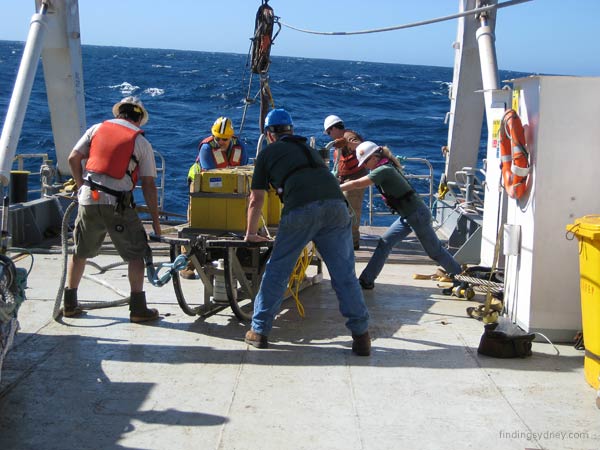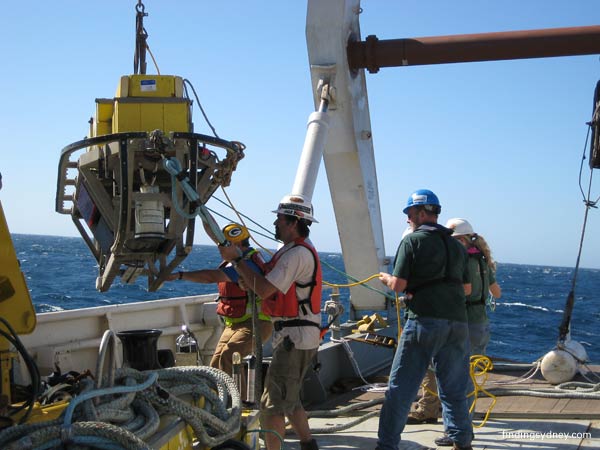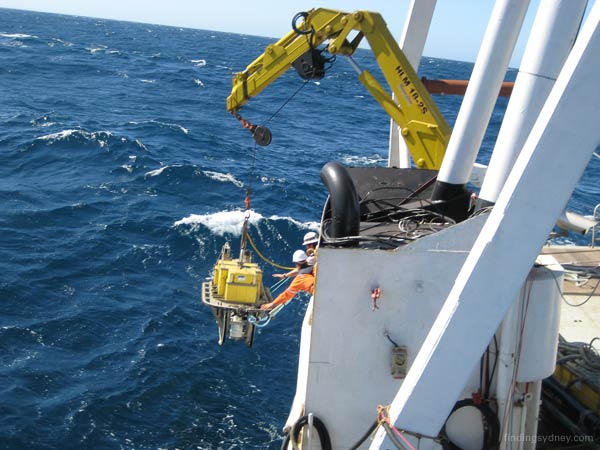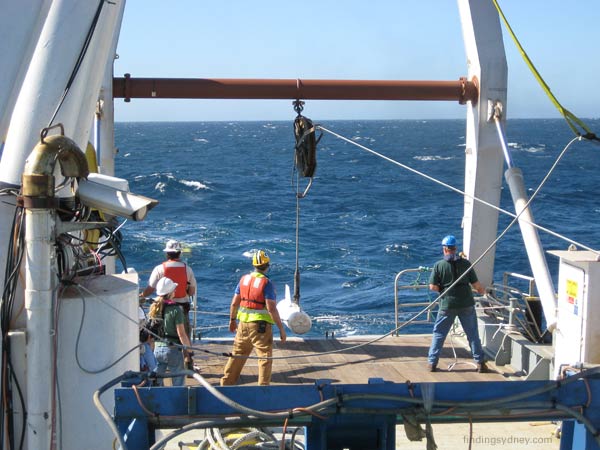David Mearns - Search Director, The Finding Sydney Foundation
Other than getting out of port safely the simple objective for today was to conduct a sea-trials of the two Williamson & Associates side-scan sonar systems before we got too far away from Geraldton and departed for the search area. Although the sonars were sea-trialled in Seattle just a couple of months ago we wanted to make sure they made the long sea-transit in perfect working condition and the only way to know this was to trial them again.
The weather (Force 5) could have been better but Williamson's crew, led by Jeff Koch running the back deck, are a well coordinated unit and working together with Geosounder's crew, the two separate launch and recoveries went quite smoothly for the first time off an unfamiliar vessel. The following pictures show the full launch sequence.

Above: steadying the sonar towfish to be lifted off the deck

Above: maneuvering the towfish over the vessel's starboard quarter

Above: lowering the towfish into the water,

Above: streaming the towfish behind the ship, and finally

Above: launching the depressor weight.
The sonar towfish is the unit that collects the imagery of the seabed and shipwrecks, while the depressor is simply a heavy weight that acts as a mechanical termination for the double-armoured steel towcable and reduces undesirable heave motions.
During the sea trials the sonars detected a very interesting target, which we used as the basis for the remaining trials. In addition to making sure that all equipment was in good working order this trial period was also used to fine-tune the sonar imagery so that it's quality is as good as possible and devoid of any extraneous sources of acoustic and electrical noise. With all equipment safely on deck by early morning we began our long transit to the search area and the start of the hunt for HMAS Sydney.
Glenys McDonald - Director, The Finding Sydney Foundation (Observer)
Our last night in Geraldton was none too restful, with the harbour surge moving the ship constantly against the wharf. We were happy to see the pilot and the wharfies unhook the mooring ropes and half an hour later we were out in the open sea with a swell running. Most people bunkered down, actually it was quite pleasant lying in my bunk with my eyes closed, but a very big swell by all accounts. I was grateful I had taken my sea sickness pills.
Late afternoon we slowed to about 4-5 knots to do a test run of the side scan sonar equipment. The Williamson crew launch the SM60 fish and it was awe inspiring, as they handled such heavy equipment on a sliding and wallowing back deck. The fish was deployed and run out 300 metres behind the ship. We were testing the equipment over a suspected anomaly, and once safely deployed, we all went back to the survey room to read the monitors. After tea, it was time to bring the SM60 back on board which was safely accomplished.
By early evening the Williamson crew were changing over the umbilical from the SM60 to the SM30 side scan sonar and latter that night she was safely deployed. It was getting dark on the back deck and I decided to call it a night, and came back to my cabin to write this first daily blog at sea. Some bright spark has written on the whiteboard outside the kitchen: “next stop Sydney”, I hope they are right.
John Perryman - Senior Historian, Royal Australian Navy (Observer)
The Australian built Bathurst class corvettes of World War II fame were renowned for being ‘maids of all work’ and for ‘rolling on wet grass’. Today as we sailed in the MV Geosounder from Geraldton on our search for the wreck of HMAS Sydney (II), I was reminded of these two quips which have been muttered by countless ‘corvette’ men in oceans the world over.
Geosounder was built in 1972, and like the corvettes of old she has been employed in both hemispheres carrying out all manner of off-shore and survey work. As we cleared Geraldton and shaped a course for our destination we were given a taste of what it may have been like to serve in the Bathurst class corvettes as our vessel of only 59.5 metres pitched, rolled and cork-screwed her way into a three metre swell. For some, who had not yet gained their sea-legs, this was a testing time as we set off on the first leg of our voyage of discovery.
Notwithstanding the buffeting of the swell, a successful launch and test trial of the Williamson side-scan sonar proceeded safely in the afternoon and evening with satisfying results. With the gear proven and the Western Australian coast line well behind us, there is now a real sense among the crew that we are finally on our way.
For more information about the Bathurst class corvettes and HMAS Sydney (II) visit: www.navy.gov.au/spc and visit the ship history
IMPORTANT NOTICE: The Material (including photographs) available in the "Press Room" section of this Website may be used/reproduced unaltered by your organisation (unless stated otherwise within the content description) subject to the terms and conditions set out in the Legal Section AND any Material (including photographs) which you use/reproduce must credit the source as "The Finding Sydney Foundation" and, as an option, you may also link the source statement with the website address http://www.findingsydney.com/.